神经科学(或神经生物学)是对神经系统的科学研究。[1] 它是生物学的多学科分支[2],它结合了生理学,解剖学,分子生物学,发育生物学,细胞学,数学建模和心理学,以了解神经元和神经回路的基本和突发特性。[3] [4] [5][6] [7] Eric Kandel将对学习,记忆,行为,感知和意识的生物学基础的理解描述为生物科学的“终极挑战”。[8]
随着时间的推移,神经科学的范围不断扩大,包括用于研究不同尺度神经系统的不同方法,神经科学家使用的技术已经大大扩展,从个体神经元的分子和细胞研究到感觉,运动和认知任务的脑成像。
视频:↓ 2分钟神经科学_神经科学方向术语
https://cache.tv.qq.com/qqplayerout.swf?vid=v0872xpcnl6
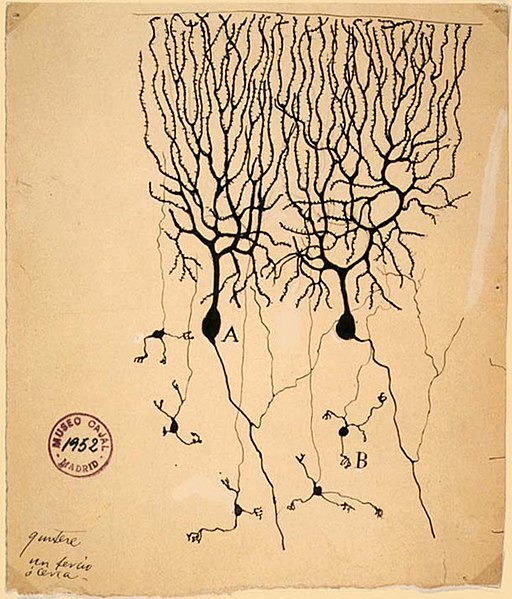
由SantiagoRamónyCajal(1899)绘制的鸽子小脑中的神经元
目录
1 历史
2 现代神经科学
2.1 分子和细胞神经科学
2.2 神经回路和系统
2.3 认知和行为神经科学
2.4 计算神经科学
2.5 转化研究和医学
3 主要分支
4 神经科学组织
4.1 公众教育和外展
5 与神经科学相关的诺贝尔奖
6 参考
历史
主要文章:神经科学的历史
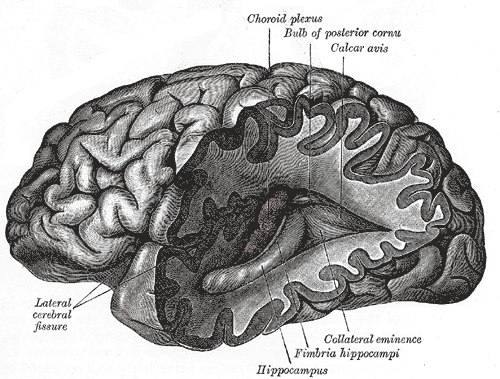
来自Gray's Anatomy(1918)的人类大脑侧面视图的插图,其中包括海马体和其他神经解剖学特征
最早的神经系统研究可以追溯到古埃及。为了治疗头部受伤或精神障碍或缓解颅压,钻孔或在洞穴内钻孔或手术练习的钻孔手术首次记录在新石器时代。可追溯到公元前1700年的手稿表明,埃及人对脑损伤的症状有一些了解。[9]
早期对大脑功能的看法认为它是一种“颅骨填充”。在埃及,从中世纪晚期开始,大脑经常被移除以准备木乃伊。当时人们认为心脏是智力的所在地。根据希罗多德的说法,木乃伊化的第一步是“取一块弯曲的铁片,然后通过鼻孔抽出大脑,从而摆脱一部分,而头骨则通过用药物冲洗而清除其余部分。 “[10]
直到希腊医生希波克拉底时,心脏才是意识之源的观点并未受到挑战。他认为大脑不仅涉及感觉 - 因为大多数专门的器官(例如,眼睛,耳朵,舌头)都位于大脑附近的头部 - 但也是智力的所在地。柏拉图还推测大脑是灵魂理性部分的所在。[11]然而,亚里士多德认为,心脏是智力的中心,大脑控制着心脏的热量。[12]这种观点被普遍接受,直到罗马医生盖伦,希波克拉底的追随者和罗马角斗士的医生,观察到他的病人在他们的大脑受到损害时失去了他们的智力。
Abulcasis,Averroes,Avicenna,Avenzoar和Maimonides活跃于中世纪的穆斯林世界,描述了许多与大脑有关的医学问题。在欧洲文艺复兴时期,Vesalius(1514-1564),RenéDescartes(1596-1650),Thomas Willis(1621-1675)和Jan Swammerdam(1637-1680)也为神经科学做出了一些贡献。
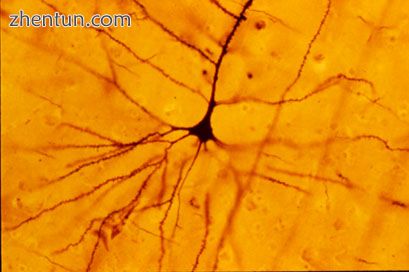
高尔基染色首先允许个体神经元的可视化。
Luigi Galvani在18世纪后期的开创性工作为研究肌肉和神经元的电兴奋性奠定了基础。在19世纪上半叶,Jean Pierre Flourens开创了实验方法,在活体动物中进行大脑的局部病变,描述它们对运动性,敏感性和行为的影响。 1843年,Emil du Bois-Reymond展示了神经信号的电学性质[13],Hermann von Helmholtz的速度开始测量[14],1875年,理查德·卡顿在兔子和猴子的大脑半球中发现了电子现象[15]。 ]阿道夫·贝克于1890年发表了类似的关于兔子和狗大脑自发电活动的观察结果。[16]在19世纪90年代后期显微镜的发明和Camillo Golgi的染色程序的发展之后,对大脑的研究变得更加复杂。该程序使用银铬酸盐来揭示单个神经元的复杂结构。他的技术被SantiagoRamónyCajal使用并导致了神经元学说的形成,这一假设认为大脑的功能单元是神经元。[17] Golgi和RamónyCajal于1906年分享了诺贝尔生理学或医学奖,因为他们对整个大脑中的神经元进行了广泛的观察,描述和分类。
与此研究同时,Paul Broca与脑损伤患者合作表明,大脑的某些区域负责某些功能。当时,Broca的研究结果被视为Franz Joseph Gall的理论的确认,即语言是局部的,并且某些心理功能局限于大脑皮层的特定区域。[18] [19] John Hughlings Jackson对癫痫患者的观察支持了功能假设的定位,他通过观察癫痫发作在身体中的进展正确推断出运动皮层的组织。 Carl Wernicke进一步发展了语言理解和生产中特定脑结构专业化的理论。通过神经成像技术进行的现代研究仍然使用布罗德曼大脑细胞构造图(指细胞结构研究)从这个时代开始的解剖学定义,继续表明皮质的不同区域在执行特定任务时被激活。[20]
在20世纪,神经科学本身开始被认为是一门独特的学科,而不是其他学科的神经系统研究。 Eric Kandel及其合作者称David Rioch,Francis O. Schmitt和Stephen Kuffler在建立该领域方面发挥了重要作用。[21]从20世纪50年代开始,Rioch起源于Walter Reed陆军研究所的基础解剖学和生理学研究与临床精神病学的整合。在同一时期,Schmitt在麻省理工学院的生物系内建立了一个神经科学研究项目,将生物学,化学,物理和数学结合在一起。第一个独立的神经科学系(当时称为心理生物学)于1964年由James L. McGaugh在加州大学欧文分校成立。[22]其次是哈佛医学院的神经生物学系,该学院由Stephen Kuffler于1966年创立。[23]
在20世纪,对神经元和神经系统功能的理解变得越来越精确和分子化。例如,1952年,艾伦·劳埃德·霍奇金(Alan Lloyd Hodgkin)和安德鲁·赫胥黎(Andrew Huxley)提出了一种数据模型,用于在鱿鱼的巨轴突神经元中传输电信号,他们将其称为“动作电位”,以及它们如何被启动和传播,称为霍奇金 - 赫胥黎模型。 1961 - 1962年,Richard FitzHugh和J. Nagumo简化了Hodgkin-Huxley,即所谓的FitzHugh-Nagumo模型。 1962年,伯纳德·卡茨(Bernard Katz)模拟神经元之间的神经传递,称为突触。从1966年开始,Eric Kandel和合作者检查了Aplysia中与学习和记忆储存相关的神经元的生化变化。 1981年,Catherine Morris和Harold Lecar将这些模型结合在Morris-Lecar模型中。这种日益量化的工作产生了许多生物神经元模型和神经计算模型。
由于对神经系统的兴趣日益增加,已经形成了几个着名的神经科学组织,为20世纪的所有神经科学家提供了一个论坛。例如,国际脑研究组织成立于1960年,[24]国际神经化学学会于1963年,[25]欧洲脑与行为学会于1968年[26]和神经科学学会于1969年成立。[27]最近,神经科学研究成果的应用也引起了应用学科的神经经济学,[28]神经教育,[29]神经伦理学[30]和神经病学[31]。
随着时间的推移,大脑研究已经经历了哲学,实验和理论阶段,预计大脑模拟工作将来会很重要。[32]
现代神经科学
主要文章:神经科学概要
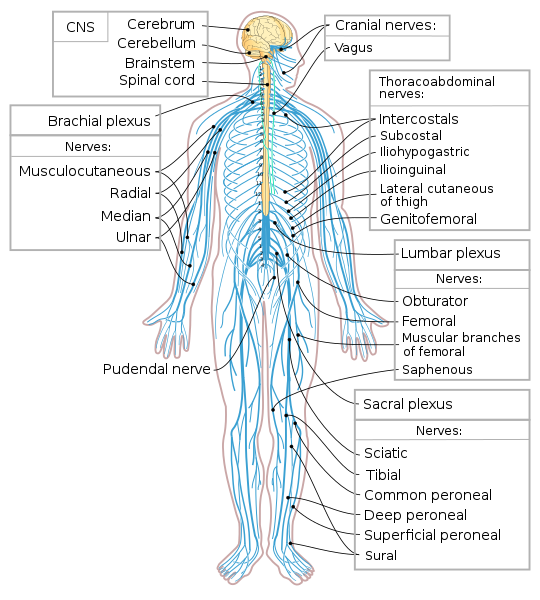
人类神经系统
在二十世纪下半叶,神经系统的科学研究显著增加,主要是由于分子生物学,电生理学和计算神经科学的进步。这使得神经科学家能够从各个方面研究神经系统:它是如何构建的,它是如何工作的,它是如何发展的,它是如何发生故障的,以及它是如何被改变的。
例如,已经可以更详细地理解在单个神经元内发生的复杂过程。神经元是专门用于通信的细胞。它们能够通过称为突触的特殊连接与神经元和其他细胞类型通信,在该连接处电或电化学信号可以从一个细胞传递到另一个细胞。许多神经元挤出称为轴突的细长轴细胞,其可延伸至身体的远端部分并且能够快速携带电信号,从而影响其终止点处的其他神经元,肌肉或腺体的活动。神经系统从彼此连接的神经元组合中出现。
脊椎动物神经系统可分为两部分:中枢神经系统(定义为脑和脊髓)和周围神经系统。在许多物种中 - 包括所有脊椎动物 - 神经系统是体内最复杂的器官系统,其大部分复杂性存在于大脑中。仅人脑包含大约一千亿个神经元和一百万亿个突触;它由数千个可区分的子结构组成,这些子结构在突触网络中相互连接,这些网络的复杂性只是开始被揭开。属于人类基因组的大约20,000个基因中至少有三个主要在大脑中表达。[33]
由于人类大脑的高度可塑性,其突触的结构及其产生的功能在整个生命中都会发生变化。[34]
理解神经系统的动态复杂性是一项艰巨的研究挑战。 最终,神经科学家希望了解神经系统的各个方面,包括它是如何工作的,它是如何发展的,它是如何发生故障的,以及它是如何被改变或修复的。 因此,神经系统的分析在多个水平上进行,范围从分子和细胞水平到系统和认知水平。 由不断扩大的知识基础和日益复杂的技术方法的可用性驱动,构成研究主要焦点的具体主题随着时间的推移而发生变化。 技术进步是推动进步的主要动力。 电子显微镜,计算机科学,电子学,功能性神经成像,遗传学和基因组学的发展都是进步的主要推动力。
分子和细胞神经科学
主要文章:分子神经科学和细胞神经科学
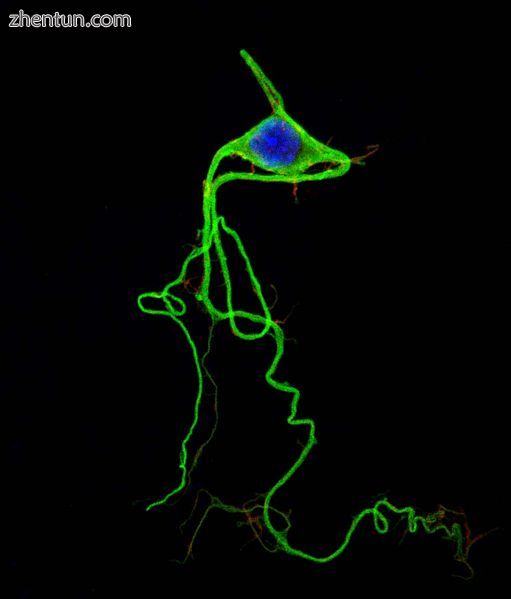
鸡胚胎中染色神经元的照片
分子神经科学中提出的基本问题包括神经元表达和响应分子信号的机制以及轴突如何形成复杂的连接模式。在这个层面,来自分子生物学和遗传学的工具被用来了解神经元如何发展以及遗传变化如何影响生物功能。神经元的形态,分子身份和生理特征以及它们与不同类型行为的关系也是相当令人感兴趣的。
细胞神经科学中提出的问题包括神经元如何在生理和电化学上处理信号的机制。这些问题包括神经突和神经元如何处理信号以及如何使用神经递质和电信号来处理神经元中的信息。神经突是来自神经细胞体的细延伸,由树突(专门用于接收来自其他神经元的突触输入)和轴突(专门用于进行称为动作电位的神经冲动)组成。 Somas是神经元的细胞体,包含细胞核。
细胞神经科学的另一个主要领域是研究神经系统的发育。问题包括神经系统的模式和区域化,神经干细胞,神经元和神经胶质的分化(神经发生和神经胶质发生),神经元迁移,轴突和树突发育,营养相互作用和突触形成。
计算神经遗传建模涉及动态神经元模型的开发,用于模拟基因和基因之间的动态相互作用的脑功能。
神经电路和系统
主要文章:神经回路和系统神经科学
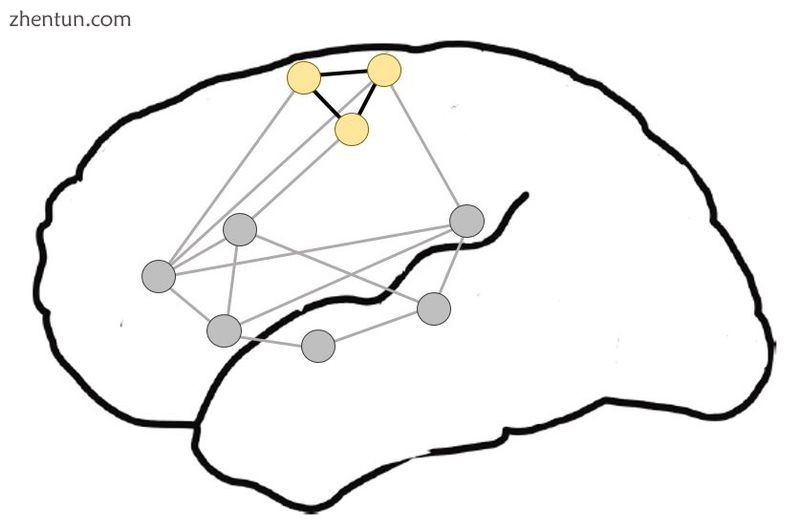
提出用于动作语言理解的运动语义神经回路的组织。改编自Shebani等人。 (2013)
系统神经科学中的问题包括如何形成神经回路并在解剖学和生理学上使用以产生诸如反射,多感觉整合,运动协调,昼夜节律,情绪反应,学习和记忆等功能。换句话说,它们解决了这些神经回路如何在大规模脑网络中发挥作用,以及产生行为的机制。例如,系统级分析解决了有关特定感觉和运动方式的问题:视力如何发挥作用?鸣禽如何通过超声波学习新歌和蝙蝠本地化?体感系统如何处理触觉信息?神经病学和神经心理学的相关领域解决了神经基质如何成为特定动物和人类行为的基础的问题。神经内分泌学和心理神经免疫学分别检查神经系统与内分泌和免疫系统之间的相互作用。尽管取得了许多进步,但神经元网络执行复杂认知过程和行为的方式仍然知之甚少。
认知和行为神经科学
主要文章:行为神经科学和认知神经科学
认知神经科学解决了神经回路如何产生心理功能的问题。强大的新测量技术的出现,如神经成像(如fMRI,PET,SPECT),脑电图,MEG,电生理学,光遗传学和人类遗传分析,结合认知心理学的复杂实验技术,使神经科学家和心理学家能够解决抽象问题,如如何认知和情绪被映射到特定的神经基质。尽管许多研究仍然采取简化立场来寻找认知现象的神经生物学基础,但最近的研究表明,神经科学研究结果与概念研究之间存在着有趣的相互作用,征求和整合两种观点。例如,关于移情的神经科学研究征求了一项涉及哲学,心理学和精神病理学的有趣的跨学科辩论。[35]此外,与不同大脑区域相关的多个记忆系统的神经科学识别已经挑战了记忆作为过去的文字再现的观念,支持记忆作为生成,建设性和动态过程的观点。[36]
神经科学还与社会和行为科学以及新生的跨学科领域结合,如神经经济学,决策理论,社会神经科学和神经营销,以解决关于大脑与环境相互作用的复杂问题。例如,对消费者反应的研究使用脑电图来研究与叙述运输相关的神经相关性,以及关于能源效率的故事。[37]
计算神经科学
主要文章:计算神经科学
计算神经科学中的问题可以涵盖广泛的传统分析水平,例如大脑的发育,结构和认知功能。 该领域的研究利用数学模型,理论分析和计算机模拟来描述和验证生物学上合理的神经元和神经系统。 例如,生物神经元模型是尖峰神经元的数学描述,可用于描述单个神经元的行为以及神经网络的动态。 计算神经科学通常被称为理论神经科学。
转化研究和医学
更多信息:转化研究和转化神经科学
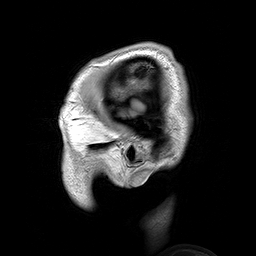
患有良性家族性巨头畸形的患者头部的矢状窦旁 MRI
神经病学,精神病学,神经外科学,精神外科学,麻醉学和疼痛医学,神经病理学,神经放射学,眼科学,耳鼻喉科学,临床神经生理学,成瘾医学和睡眠医学是一些专门针对神经系统疾病的医学专业。这些术语还涉及涉及这些疾病的诊断和治疗的临床学科。
神经病学与中枢和外周神经系统疾病一起使用,例如肌萎缩侧索硬化症(ALS)和中风,以及它们的医学治疗。精神病学专注于情感,行为,认知和感知障碍。麻醉学着重于对疼痛的感知和意识的药理学改变。神经病理学侧重于中枢和外周神经系统和肌肉疾病的分类和潜在致病机制,重点是形态学,微观和化学上可观察到的改变。神经外科和精神外科主要用于中枢和外周神经系统疾病的外科手术治疗。
最近,各种专业之间的界限已经模糊,因为它们都受到神经科学基础研究的影响。例如,脑成像能够客观地了解精神疾病,从而更快地诊断,更准确的预后,并改善对患者进展的监测。[38]
综合神经科学描述了将来自多个研究水平的模型和信息结合起来以开发神经系统的连贯模型的努力。例如,脑成像与生理数值模型和基本机制理论相结合可能会揭示精神疾病。[39]
主要分支
现代神经科学教育和研究活动可以大致分为以下主要分支,基于检查系统的主题和规模以及不同的实验或课程方法。然而,个别神经科学家经常研究跨越几个不同子域的问题。
神经科学组织
最大的专业神经科学组织是神经科学学会(SFN),该学院位于美国,但包括来自其他国家的许多成员。自1969年成立以来,SFN稳步发展:截至2010年,它记录了来自83个不同国家的40,290名成员。[43]每年在美国不同城市举行的年度会议吸引了研究人员,博士后研究生,研究生和本科生,以及教育机构,资助机构,出版商和数百家提供研究用产品的企业。
其他致力于神经科学的主要组织包括国际脑研究组织(IBRO)和欧洲神经科学学会联合会(FENS),该组织每年在世界不同地区举行会议,该组织在每两年一次的欧洲城市。 FENS由32个国家级组织组成,包括英国神经科学协会,德国神经科学学会(Neurowissenschaftliche Gesellschaft)和法国SociétédesNeurosciences。第一个神经科学国家荣誉学会Nu Rho Psi成立于2006年。
2013年,BRAIN Initiative在美国宣布。
公共教育和外展
除了在实验室环境中进行传统研究外,神经科学家还参与了促进公众和政府官员对神经系统的认识和了解。个人神经科学家和大型组织都做过这种促销活动。例如,个别神经科学家通过组织国际脑蜂,促进了年轻学生的神经科学教育,这是一项针对全球高中或中学学生的学术竞赛。[44]在美国,神经科学学会等大型组织通过开发名为Brain Facts的入门推广神经科学教育,[45]与公立学校教师合作,为K-12教师和学生开发神经科学核心概念,[46]与Dana基金会合作开展一项名为“脑意识周”的活动,以提高公众对大脑研究进展和益处的认识。[47]在加拿大,CIHR加拿大国家脑蜂每年在麦克马斯特大学举行。[48]
神经科学教育工作者于1992年成立了本科神经科学(FUN)学院,分享最佳实践并为参加神经科学学会会议的本科生提供旅行奖励。[49]
最后,神经科学家还与其他教育专家合作,研究和完善教育技术,以优化学生的学习,这是一个新兴的领域,称为教育神经科学。[50] 美国联邦机构,如国立卫生研究院(NIH)[51]和国家科学基金会(NSF)[52]也资助了有关神经科学概念教学和学习最佳实践的研究。
另见
List of neuroscience databases
List of neuroscience journals
List of neuroscience topics
List of neuroscientists
Neuroplasticity
Outline of brain mapping
Outline of the human brain
List of regions in the human brain
Gut–brain axis
Connectomics
参考
"Neuroscience". Merriam-Webster Medical Dictionary.
"Neurobiology". Dictionary.com. Retrieved 2017-01-22.
Kandel, Eric R. (2012). Principles of Neural Science, Fifth Edition. McGraw-Hill Education. pp. I. Overall perspective. ISBN 978-0071390118.
Ayd, Frank J., Jr. (2000). Lexicon of Psychiatry, Neurology and the Neurosciences. Lippincott, Williams & Wilkins. p. 688. ISBN 978-0781724685.
Shulman, Robert G. (2013). "Neuroscience: A Multidisciplinary, Multilevel Field". Brain Imaging: What it Can (and Cannot) Tell Us About Consciousness. Oxford University Press. p. 59. ISBN 9780199838721.
Ogawa, Hiroto; Oka, Kotaro (2013). Methods in Neuroethological Research. Springer. p. v. ISBN 9784431543305.
Tanner, Kimberly D. (2006-01-01). "Issues in Neuroscience Education: Making Connections". CBE— Life Sciences Education. 5 (2): 85. doi:10.1187/cbe.06-04-0156. ISSN 1931-7913. PMC 1618510.
Kandel, Eric R. (2012). Principles of Neural Science, Fifth Edition. McGraw-Hill Education. p. 5. ISBN 978-0071390118. The last frontier of the biological sciences – their ultimate challenge – is to understand the biological basis of consciousness and the mental processes by which we perceive, act, learn, and remember.
Mohamed W (2008). "The Edwin Smith Surgical Papyrus: Neuroscience in Ancient Egypt". IBRO History of Neuroscience. Retrieved 2014-07-06.
Herodotus (2009) [440 BCE]. The Histories: Book II (Euterpe). Translated by George Rawlinson.
Plato (2009) [360 BCE]. Timaeus. Translated by George Rawlinson.
Finger, Stanley (2001). Origins of Neuroscience: A History of Explorations into Brain Function (3rd ed.). New York: Oxford University Press, USA. pp. 3–17. ISBN 978-0-19-514694-3.
Finkelstein, Gabriel (2013). Emil du Bois-Reymond: Neuroscience, Self, and Society in Nineteenth-Century Germany. Cambridge; London: The MIT Press. pp. 72–74, 89–95. ISBN 9780262019507.
Harrison, David W. (2015). Brain Asymmetry and Neural Systems Foundations in Clinical Neuroscience and Neuropsychology. Springer International Publishing. pp. 15–16. ISBN 978-3-319-13068-2.
"Caton, Richard - The electric currents of the brain". echo.mpiwg-berlin.mpg.de. Retrieved 2018-12-21.
Coenen, Anton; Edward Fine; Oksana Zayachkivska (2014). "Adolf Beck: A Forgotten Pioneer In Electroencephalography". Journal of the History of the Neurosciences. 23 (3): 276–286. doi:10.1080/0964704x.2013.867600. PMID 24735457.
Guillery, R (Jun 2005). "Observations of synaptic structures: origins of the neuron doctrine and its current status". Philos Trans R Soc Lond B Biol Sci. 360 (1458): 1281–307. doi:10.1098/rstb.2003.1459. PMC 1569502. PMID 16147523.
Greenblatt SH (1995). "Phrenology in the science and culture of the 19th century". Neurosurgery. 37 (4): 790–805. doi:10.1227/00006123-199510000-00025. PMID 8559310.
Bear MF; Connors BW; Paradiso MA (2001). Neuroscience: Exploring the Brain (2nd ed.). Philadelphia: Lippincott Williams & Wilkins. ISBN 978-0-7817-3944-3.
Kandel ER; Schwartz JH; Jessel TM (2000). Principles of Neural Science (4th ed.). New York: McGraw-Hill. ISBN 978-0-8385-7701-1.
Cowan, W.M.; Harter, D.H.; Kandel, E.R. (2000). "The emergence of modern neuroscience: Some implications for neurology and psychiatry". Annual Review of Neuroscience. 23: 345–346. doi:10.1146/annurev.neuro.23.1.343. PMID 10845068.
"James McGaugh". The history of neuroscience in autobiography. Volume. 4. Squire, Larry R., Society for Neuroscience. Washington DC: Society for Neuroscience. 1996. p. 410. ISBN 0916110516. OCLC 36433905.
"History - Department of Neurobiology".
"History of IBRO". International Brain Research Organization. 2010.[dead link]
The Beginning Archived April 21, 2012, at the Wayback Machine, International Society for Neurochemistry
"About EBBS". European Brain and Behaviour Society. 2009. Archived from the original on 2016-03-03.
"About SfN". Society for Neuroscience.
"How can neuroscience inform economics?" (PDF). Current Opinion in Behavioral Sciences.
Zull, J. (2002). The art of changing the brain: Enriching the practice of teaching by exploring the biology of learning. Sterling, Virginia: Stylus Publishing, LLC
"What is Neuroethics?". www.neuroethicssociety.org. Retrieved 2019-02-22.
Petoft, Arian (2015-01-05). "Neurolaw: A brief introduction". Iranian Journal of Neurology. 14 (1): 53–58. ISSN 2008-384X. PMC 4395810. PMID 25874060.
Fan, Xue; Markram, Henry (2019-05-07). "A Brief History of Simulation Neuroscience". Frontiers in Neuroinformatics. 13. doi:10.3389/fninf.2019.00032. ISSN 1662-5196.
U.S. National Institute of Neurological Disorders and Stroke. Brain basics: genes at work in the brain. Date last modified: 2018-12-27. [1] Retrieved Feb. 4, 2019.
The United States Department of Health and Human Services. Mental Health: A Report of the Surgeon General. "Chapter 2: The Fundamentals of Mental Health and Mental Illness" pp 38 [2] Retrieved May 21, 2012
Aragona M, Kotzalidis GD, Puzella A. (2013) The many faces of empathy, between phenomenology and neuroscience. Archives of Psychiatry and Psychotherapy, 4:5-12 http://www.archivespp.pl/uploads ... gona_APP_4_2013.pdf
Ofengenden, Tzofit (2014). "Memory formation and belief" (PDF). Dialogues in Philosophy, Mental and Neuro Sciences. 7 (2): 34–44.
Gordon, Ross; Ciorciari, Joseph; Van Laer, Tom (2018). "Using EEG to examine the role of attention, working memory, emotion, and imagination in narrative transportation". European Journal of Marketing. 52: 92–117. doi:10.1108/EJM-12-2016-0881. SSRN 2892967.
Lepage M (2010). "Research at the Brain Imaging Centre". Douglas Mental Health University Institute. Archived from the original on March 5, 2012.
Gordon E (2003). "Integrative neuroscience". Neuropsychopharmacology. 28 Suppl 1: S2–8. doi:10.1038/sj.npp.1300136. PMID 12827137.
Panksepp J (1990). "A role for "affective neuroscience" in understanding stress: the case of separation distress circuitry". In Puglisi-Allegra S; Oliverio A (eds.). Psychobiology of Stress. Dordrecht, Netherlands: Kluwer Academic. pp. 41–58. ISBN 978-0-7923-0682-5.
Chiao, J.Y. & Ambady, N. (2007). Cultural neuroscience: Parsing universality and diversity across levels of analysis. In Kitayama, S. and Cohen, D. (Eds.) Handbook of Cultural Psychology, Guilford Press, New York, pp. 237-254.
1933-, Shepherd, Gordon M. Neurogastronomy : how the brain creates flavor and why it matters. ISBN 9780231159111. OCLC 882238865.
"Financial and organizational highlights" (PDF). Society for Neuroscience. Archived from the original (PDF) on September 15, 2012.
"About the International Brain Bee". The International Brain Bee.
"Brain Facts: A Primer on the Brain and Nervous System". Society for Neuroscience.
"Neuroscience Core Concepts: The Essential Principles of Neuroscience". Society for Neuroscience. Archived from the original on April 15, 2012.
"Brain Awareness Week Campaign". The Dana Foundation.
"Official CIHR Canadian National Brain Bee Website". Archived from the original on May 30, 2014. Retrieved 24 September 2014.
https://funfaculty.org/drupal/About_FUN
Goswami U (2004). "Neuroscience, education and special education". Br J Spec Educ. 31 (4): 175–183. doi:10.1111/j.0952-3383.2004.00352.x.
"The SEPA Program". NIH. Archived from the original on September 20, 2011. Retrieved September 23, 2011.
"About Education and Human Resources". NSF. Retrieved September 23, 2011.
"The Nobel Prize in Physiology or Medicine 1904". Nobel Foundation. Retrieved 28 July 2007.
"The Nobel Prize in Physiology or Medicine 1906". Nobel Foundation. Retrieved 28 July 2007.
"The Nobel Prize in Physiology or Medicine 1914". Nobel Foundation. Retrieved 28 July 2007.
"The Nobel Prize in Physiology or Medicine 1932". Nobel Foundation. Retrieved 28 July 2007.
"The Nobel Prize in Physiology or Medicine 1936". Nobel Foundation. Retrieved 28 July 2007.
"The Nobel Prize in Physiology or Medicine 1944". Nobel Foundation. Retrieved 28 July 2007.
"The Nobel Prize in Physiology or Medicine 1949". Nobel Foundation. Retrieved 28 July 2007.
"The Nobel Prize in Physiology or Medicine 1957". Nobel Foundation. Retrieved 28 July 2007.
"The Nobel Prize in Physiology or Medicine 1961". Nobel Foundation. Retrieved 28 July 2007.
"The Nobel Prize in Physiology or Medicine 1970". Nobel Foundation.
"The Nobel Prize in Physiology or Medicine 1981". Nobel Foundation.
Cite error: The named reference n1997 was invoked but never defined (see the help page).
"The Nobel Prize in Physiology or Medicine 2000". Nobel Foundation. Retrieved 28 July 2007.
"The Nobel Prize in Chemistry 2003". Nobel Foundation. Retrieved 4 April 2019.
"The Nobel Prize in Physiology or Medicine 2014". Nobel Foundation. Retrieved 7 October 2013.
"The Nobel Prize in Physiology or Medicine 2017". Nobel Foundation. Retrieved 2 October 2017.
Further reading
Bear, M. F.; B. W. Connors; M. A. Paradiso (2006). Neuroscience: Exploring the Brain (3rd ed.). Philadelphia: Lippincott. ISBN 978-0-7817-6003-4.
Binder, Marc D.; Hirokawa, Nobutaka; Windhorst, Uwe, eds. (2009). Encyclopedia of Neuroscience. Springer. ISBN 978-3-540-23735-8.
Kandel, ER; Schwartz JH; Jessell TM (2012). Principles of Neural Science (5th ed.). New York: McGraw-Hill. ISBN 978-0-8385-7701-1.
Squire, L. et al. (2012). Fundamental Neuroscience, 4th edition. Academic Press; ISBN 0-12-660303-0
Byrne and Roberts (2004). From Molecules to Networks. Academic Press; ISBN 0-12-148660-5
Sanes, Reh, Harris (2005). Development of the Nervous System, 2nd edition. Academic Press; ISBN 0-12-618621-9
Siegel et al. (2005). Basic Neurochemistry, 7th edition. Academic Press; ISBN 0-12-088397-X
Rieke, F. et al. (1999). Spikes: Exploring the Neural Code. The MIT Press; Reprint edition ISBN 0-262-68108-0
section.47 Neuroscience 2nd ed. Dale Purves, George J. Augustine, David Fitzpatrick, Lawrence C. Katz, Anthony-Samuel LaMantia, James O. McNamara, S. Mark Williams. Published by Sinauer Associates, Inc., 2001.
section.18 Basic Neurochemistry: Molecular, Cellular, and Medical Aspects 6th ed. by George J. Siegel, Bernard W. Agranoff, R. Wayne Albers, Stephen K. Fisher, Michael D. Uhler, editors. Published by Lippincott, Williams & Wilkins, 1999.
Andreasen, Nancy C. (March 4, 2004). Brave New Brain: Conquering Mental Illness in the Era of the Genome. Oxford University Press. ISBN 978-0-19-514509-0. Archived from the original on February 24, 2007.
Damasio, A. R. (1994). Descartes' Error: Emotion, Reason, and the Human Brain. New York, Avon Books. ISBN 0-399-13894-3 (Hardcover) ISBN 0-380-72647-5 (Paperback)
Gardner, H. (1976). The Shattered Mind: The Person After Brain Damage. New York, Vintage Books, 1976 ISBN 0-394-71946-8
Goldstein, K. (2000). The Organism. New York, Zone Books. ISBN 0-942299-96-5 (Hardcover) ISBN 0-942299-97-3 (Paperback)
Lauwereyns, Jan (February 2010). The Anatomy of Bias: How Neural Circuits Weigh the Options. Cambridge, Massachusetts: The MIT Press. ISBN 978-0-262-12310-5.
Subhash Kak, The Architecture of Knowledge: Quantum Mechanics, Neuroscience, Computers and Consciousness, Motilal Banarsidass, 2004, ISBN 81-87586-12-5
Llinas R. (2001). I of the Vortex: From Neurons to Self MIT Press. ISBN 0-262-12233-2 (Hardcover) ISBN 0-262-62163-0 (Paperback)
Luria, A. R. (1997). The Man with a Shattered World: The History of a Brain Wound. Cambridge, Massachusetts, Harvard University Press. ISBN 0-224-00792-0 (Hardcover) ISBN 0-674-54625-3 (Paperback)
Luria, A. R. (1998). The Mind of a Mnemonist: A Little Book About A Vast Memory. New York, Basic Books, Inc. ISBN 0-674-57622-5
Medina, J. (2008). Brain Rules: 12 Principles for Surviving and Thriving at Work, Home, and School. Seattle, Pear Press. ISBN 0-9797777-0-4 (Hardcover with DVD)
Pinker, S. (1999). How the Mind Works. W. W. Norton & Company. ISBN 0-393-31848-6
Pinker, S. (2002). The Blank Slate: The Modern Denial of Human Nature. Viking Adult. ISBN 0-670-03151-8
Robinson, D. L. (2009). Brain, Mind and Behaviour: A New Perspective on Human Nature (2nd ed.). Dundalk, Ireland: Pontoon Publications. ISBN 978-0-9561812-0-6.
Penrose, R., Hameroff, S. R., Kak, S., & Tao, L. (2011). Consciousness and the universe: Quantum physics, evolution, brain & mind. Cambridge, MA: Cosmology Science Publishers.
Ramachandran, V. S. (1998). Phantoms in the Brain. New York, HarperCollins. ISBN 0-688-15247-3 (Paperback)
Rose, S. (2006). 21st Century Brain: Explaining, Mending & Manipulating the Mind ISBN 0-09-942977-2 (Paperback)
Sacks, O. The Man Who Mistook His Wife for a Hat. Summit Books ISBN 0-671-55471-9 (Hardcover) ISBN 0-06-097079-0 (Paperback)
Sacks, O. (1990). Awakenings. New York, Vintage Books. (See also Oliver Sacks) ISBN 0-671-64834-9 (Hardcover) ISBN 0-06-097368-4 (Paperback)
Encyclopedia:Neuroscience Scholarpedia Expert articles
Sternberg, E. (2007) Are You a Machine? The Brain, the Mind and What it Means to be Human. Amherst, New York: Prometheus Books.
Churchland, P. S. (2011) Braintrust: What Neuroscience Tells Us about Morality. Princeton University Press. ISBN 0-691-13703-X
Selvin, Paul (2014) "Hot Topics presentation: New Small Quantum Dots for Neuroscience. SPIE Newsroom, doi:10.1117/2.3201403.17 |